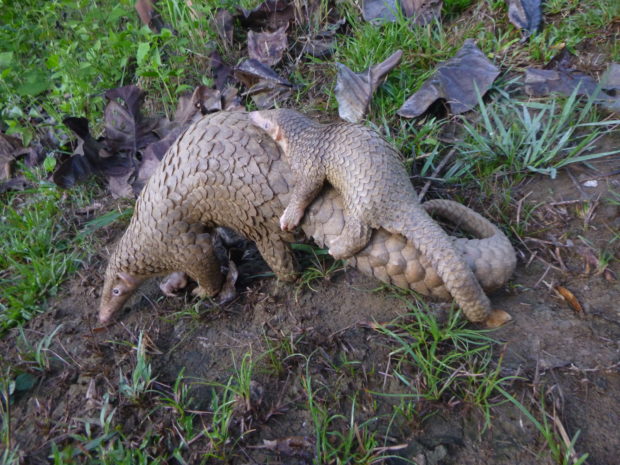
ENDANGERED A Philippine pangolin, one of the world’s most trafficked mammals, and her baby are sighted by census takers in the Victoria-Anepahan Mountain Range in Palawan province. —PHOTOS COURTESY OF USAID PROTECT WILDLIFE AND KATALA FOUNDATION
MANILA, Philippines — Only 17 Philippine pangolins (Manis culionensis) were found in a survey of 2,400 hectares of forests in the Victoria-Anepa-han Mountain Range in Palawan province, according to a recent study that sought to determine the presence of one of the world’s most trafficked mammals and the threats to their survival.
Led by the wildlife group Katala Foundation and funded by USAID Protect Wildlife, the study ran from 2018 to 2019 in an attempt to update the limited information available about the Philippine pangolin, locally known as “balintong.”
One of eight species around the world, it was only recently described as distinct from the Sunda pangolin (Manis java¬nica), which is found in several countries in Southeast Asia.
The situation of this shy, scaly mammal was reflected in its recent reclassification as a critically endangered species on the International Union for Conservation of Nature’s Red List, with loss of habitat and poaching among the main drivers for its shrinking numbers.
12 expeditions
Together with local guides and dogs, researchers from Katala went on 12 expeditions in thick forests, looking for clues that could lead to the elusive pangolin, such as ant and termite trails, tree scratches, ground diggings and scent marks.
After a dozen painstaking trips, however, researchers found only a handful of pangolins, including a nursing baby, juveniles and pregnant ones.
In half of those expeditions—which were done in the dead of night since these animals are nocturnal—not a single pangolin was found.
Dr. Sabine Schoppe, who led the survey, said this count was much smaller than the number from similar ground surveys done in other areas of Palawan in the previous years.
“This is less than half the number of individuals, which reached 36, compared to the surveys in six sites done by the Katala Foundation between 2013 and November 2014,” Schoppe told the Inquirer.
Complicated
While the pangolins were fewer in number, she said it was still complicated to exactly determine whether there was a significant decline over the years, since various research methods and sites were used in the studies.
“There are anecdotal records that pangolins are or were generally more abundant in the north compared to the south of Palawan,” she noted.
What is clear in the recent study, however, was that forest conditions translated to whether pangolins would be present in particular sites.
Aside from ground survey, the expeditions used camera traps with motion sensors. More than 30 cameras were positioned on each plot stretching 3,300 ha.
A researcher studies another pangolin. In areas with more threats to biodiversity, such as illegal logging and slash-and-burn farming, fewto no pangolins or any other animals were found. —PHOTO COURTESY OF USAID PROTECT WILDLIFE AND KATALA FOUNDATION
After more than 7,300 days, the cameras recorded around one to four pangolins on each plot.
While this rate was low, photos showed that diverse wildlife still thrive in Victoria-Anepahan, including species endemic to Palawan such as the porcupine, peacock-pheasant, bearded pig, leopard cat and stink badger.
But in areas where there were more threats to biodiversity, such as illegal logging and slash-and-burn farming, few to no pangolins or any other animals were found.
USAID Protect Wildlife said that in one expedition, the researchers surveyed a heavily logged area, describing it as an “empty forest.” They also came across illegal loggers with chainsaws intimidating the research team in one incident.
No legal protection
While it was declared a key biodiversity area, the 165,000-ha mountain range has no existing legal protection, and thus, no conservation measures are in place to safeguard the forests and their inhabitants.
“Using the findings of the study, specific priority areas for pangolin conservation in Victoria-Anepahan can now be drawn from sites with the most number of pangolin sightings and with fewer threats to forests and wildlife,” said USAID Protect Wildlife.
Stronger enforcement, meanwhile, can also help reduce the pressure on the already fragile pangolin population, which is threatened by illegal wildlife trade.
Poaching continues
Part of the study, led this time by Palawan State University, showed that pangolin poaching and trafficking continue because of demand from buyers. Both buyers and hunters can come from as far as Puerto Princesa City and other northern towns in Palawan.
Fresh scales, which are heavily used in traditional Asian medicine despite having no proven medicinal value, can sell for up to P4,500 per kilo. Dried ones can fetch up to P7,000 per kilo. Pangolin meat, a delicacy in some Asian countries, can command up to P300 per kilo.
Community members interviewed for the study cited poverty and lack of livelihood as among their reasons for entering the illegal trade.
Following the conclusion of the study, USAID said it would continue to work with local partners, including the Palawan Council for Sustainable Development, to develop a conservation plan for the Philippine pangolin.
“The survival of the Philippine pangolin does not solely depend on research and resources but, to a large extent, on demand reduction, law enforcement and political will,” Schoppe said.